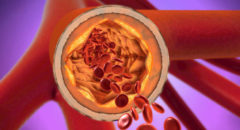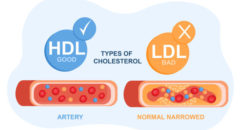
Heart failure is a condition where the heart cannot pump enough blood throughout
the body. Heart failure does not mean that your heart has stopped or is about
to stop working. It means that your heart is not able to pump blood the way
that it should. The heart cannot fill with enough blood or pump with enough
force or both. Go to the section on How the Heart Works for details.
Heart failure develops over time as the pumping action of the heart
grows weaker. It can affect the left side, the right side, or both sides of the
heart. Most cases involve the left side where the heart cannot pump enough
oxygen-rich blood to the rest of the body. With right-sided failure, the heart
cannot effectively pump blood to the lungs where the blood picks up oxygen.
The weakening of the pumping ability of the heart causes:
- Blood and fluid to “back up” into the lungs
- The buildup of fluid in the feet, ankles, and legs
- Tiredness and shortness of breath
Heart failure is a serious condition. About 5 million people in the U. S.
have heart failure and the number is growing. Each year, another 550,000 people
are diagnosed for the first time. It contributes to or causes about 300,000
deaths each year.
How the Heart Works
Your heart is a
muscle that is about the size of your fist. It works like a pump and it is
always pumping blood throughout the body. The average heart beats 100,000 times
a day.
The heart has a left and right side, separated by a wall of
muscle called the septum. Blood vessels called veins bring blood
to the heart, while other blood vessels called arteries carry blood away
from the heart. Here is what happens:
- Blood from your body enters the right side of your heart through veins. The
blood is dark because it has given all its oxygen to your body. - The right side of the heart pumps the blood through the pulmonary
artery to your lungs to pick up oxygen. - After traveling through the lungs, the blood turns bright red because it is
rich in oxygen. - The oxygen-rich blood then returns to the left side of your heart and is
pumped out to your body through the large artery called the aorta.
Heart chambers. The heart has four chambers or “rooms”-two on each
side. The upper chambers are called atria and the lower chambers are
called ventricles. The atria collect blood as it comes into the heart. As
your heart beats, blood is pumped from the atria through valves down into the
ventricles. Then, blood is pumped from the ventricles out of the heart through
different valves.
Heart valves. The heart has four valves that
open and close, like doors, to control the flow of blood through the heart in
one direction. The four valves are:
- Tricuspid valve, between the right atrium and the right ventricle
- Pulmonary valve, between the right ventricle and the entrance to the
pulmonary artery - Mitral valve, between the left atrium and the left ventricle
- Aortic valve, between the left ventricle and the entrance to the
aorta.
Each time your heart beats, it makes the familiar “lub-DUB” sounds. These are
the sounds of valves in the heart closing.
Arteries. The arteries
attached to the heart are:
- The aorta, the main artery that carries oxygen-rich blood from the left side
of the heart to the body - The pulmonary artery, which carries blood from the right side of the heart
to the lungs to pick up oxygen.
The heart also has arteries on its outside surface called the coronary
arteries. These important arteries supply the heart muscle itself with the
oxygen-rich blood it needs to work normally.
Other Names for
Heart Failure
- Congestive heart failure or CHF (when the poor pumping function results in
symptoms) - Left-sided heart failure
- Right-sided heart failure
- Systolic heart failure
- Diastolic heart failure
What Causes Heart Failure?
Heart failure is caused by
other diseases or conditions that damage or overwork the heart muscle. Over time
the heart muscle weakens and is not able to pump blood as well as it should.
The leading causes of heart failure are:
- Coronary artery disease (CAD)
- High blood pressure
- Diabetes.
CAD, including angina and heart attack, is the most common underlying cause
of heart failure. Persons who have a heart attack are at high risk of developing
heart failure.
Most people with heart failure also have high blood
pressure and about 1 in 3 has diabetes.
Other Causes of Heart
Failure
Other heart diseases and conditions that can lead to heart
failure are:
- Cardiomyopathy (a disease of the heart muscle)
- Diseases of the heart valves
- Abnormal heartbeats or arrhythmias
- Congenital heart disease (a heart defect or problem you are born with).
Other conditions that may injure the heart muscle and lead to heart failure
include:
- Treatments for cancer such as radiation and certain chemotherapy drugs
- Thyroid disorders-having either too much or too little thyroid hormone in
the body - Alcohol abuse
- HIV/AIDS
- Cocaine and other illegal drugs use.
Who Gets Heart Failure?
Heart failure can happen to
anyone, but it is more common in:
- People 65 years of age and older
- African Americans.
Heart failure is very common in persons 65 years of age and older. It is the
number one reason for a hospital visit in this group.
Blacks are more
likely to have heart failure and suffer more severely from it. Blacks are more
likely to:
- Develop symptoms at an earlier age
- Have their heart failure get worse faster
- Have more hospital visits
- Die from heart failure.
Men also have a higher rate of heart failure than women. But in actual
numbers, more women have heart failure because many more women live into their
70s and 80s when heart failure is common.
Children with congenital heart
disease can also get heart failure. Congenital heart disease happens when the
heart, heart valves, and/or blood vessels near the heart do not develop
correctly in babies when they are in the womb. This can weaken the heart muscle
and lead to heart failure. Children do not have the same symptoms or get the
same treatment for heart failure as adults and will not be discussed here.
What Are the Signs and Symptoms of Heart Failure?
The
most common signs and symptom are:
- Shortness of breath or difficulty breathing
- Feeling tired
- Swelling in the ankles, feet, legs, and sometimes the abdomen.
Shortness of breath and feeling tired are caused by the buildup of fluid
in the lungs and around the lung (pleural effusions). When symptoms start,
you may feel tired and short of breath after routine physical exertion. Climbing
two flights of stairs makes you feel winded. As heart failure progresses, the
symptoms get worse. You may begin to feel tired and short of breath after simple
activities, like getting dressed or walking across the room. Some people have
shortness of breath when lying flat.
Fluid buildup in the lungs can
also cause a cough. The cough is worse at night and when you are lying down.
Excessive fluid in the lungs can cause a life-threatening condition called acute
pulmonary edema. This condition requires emergency treatment.
The
swelli








